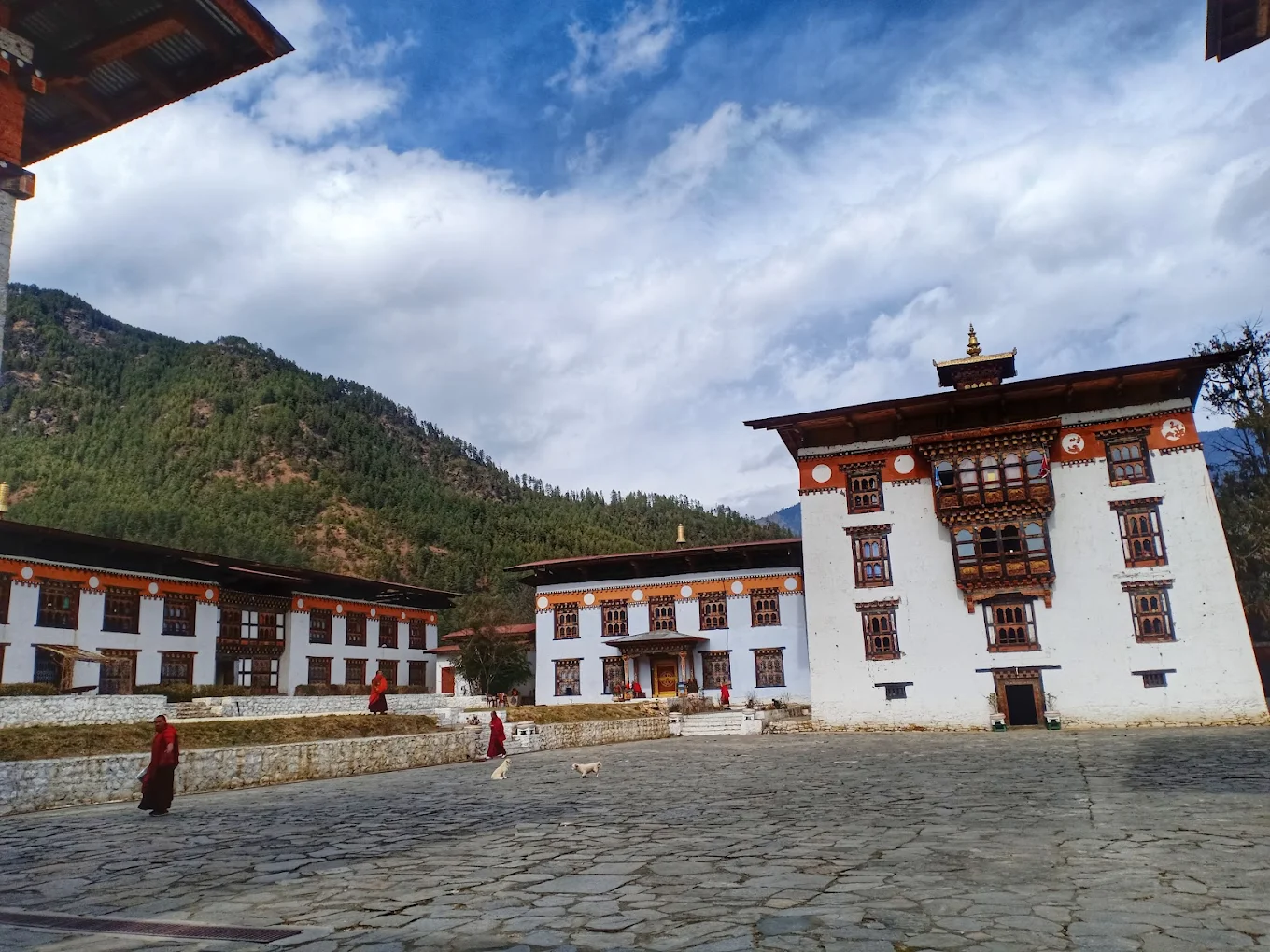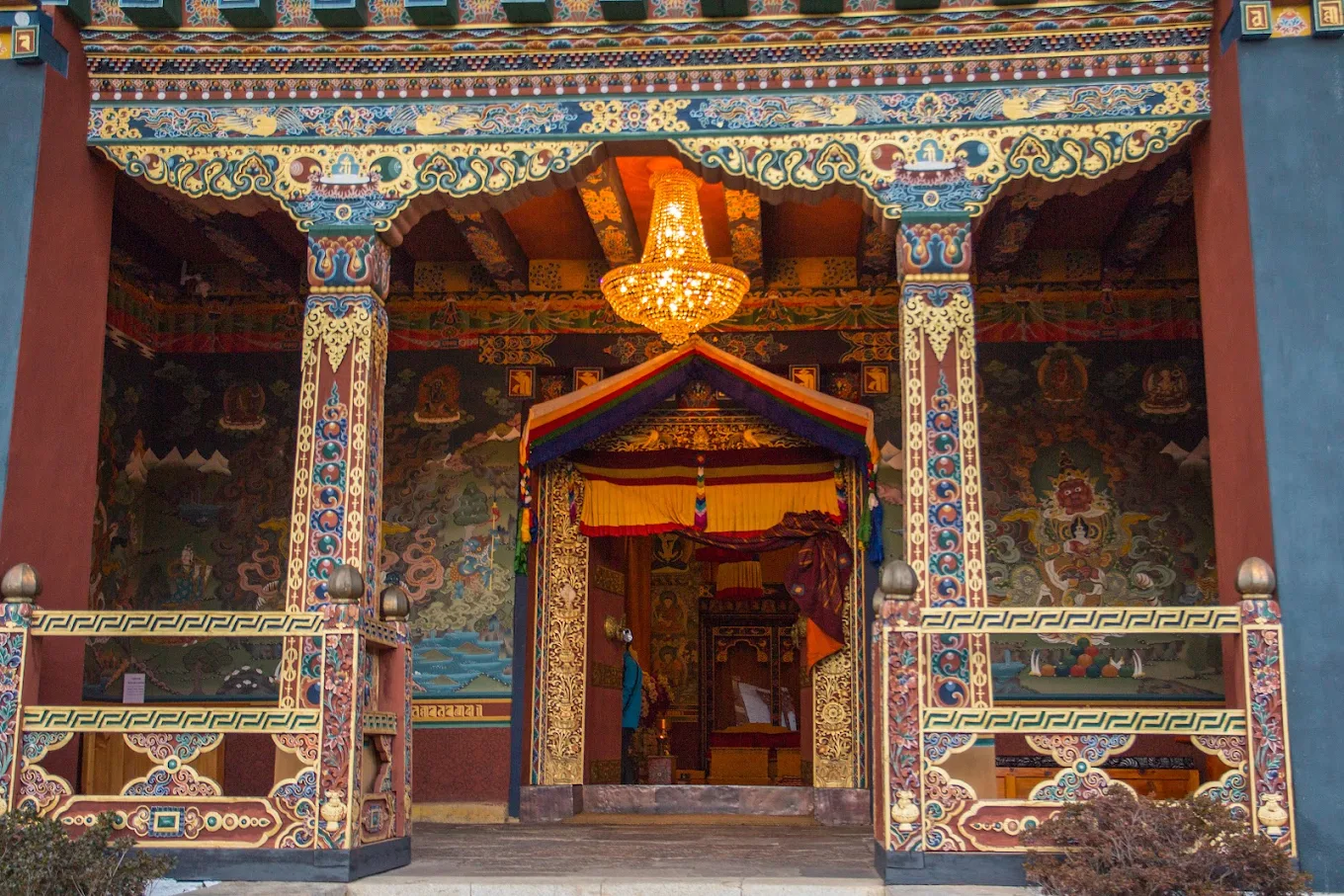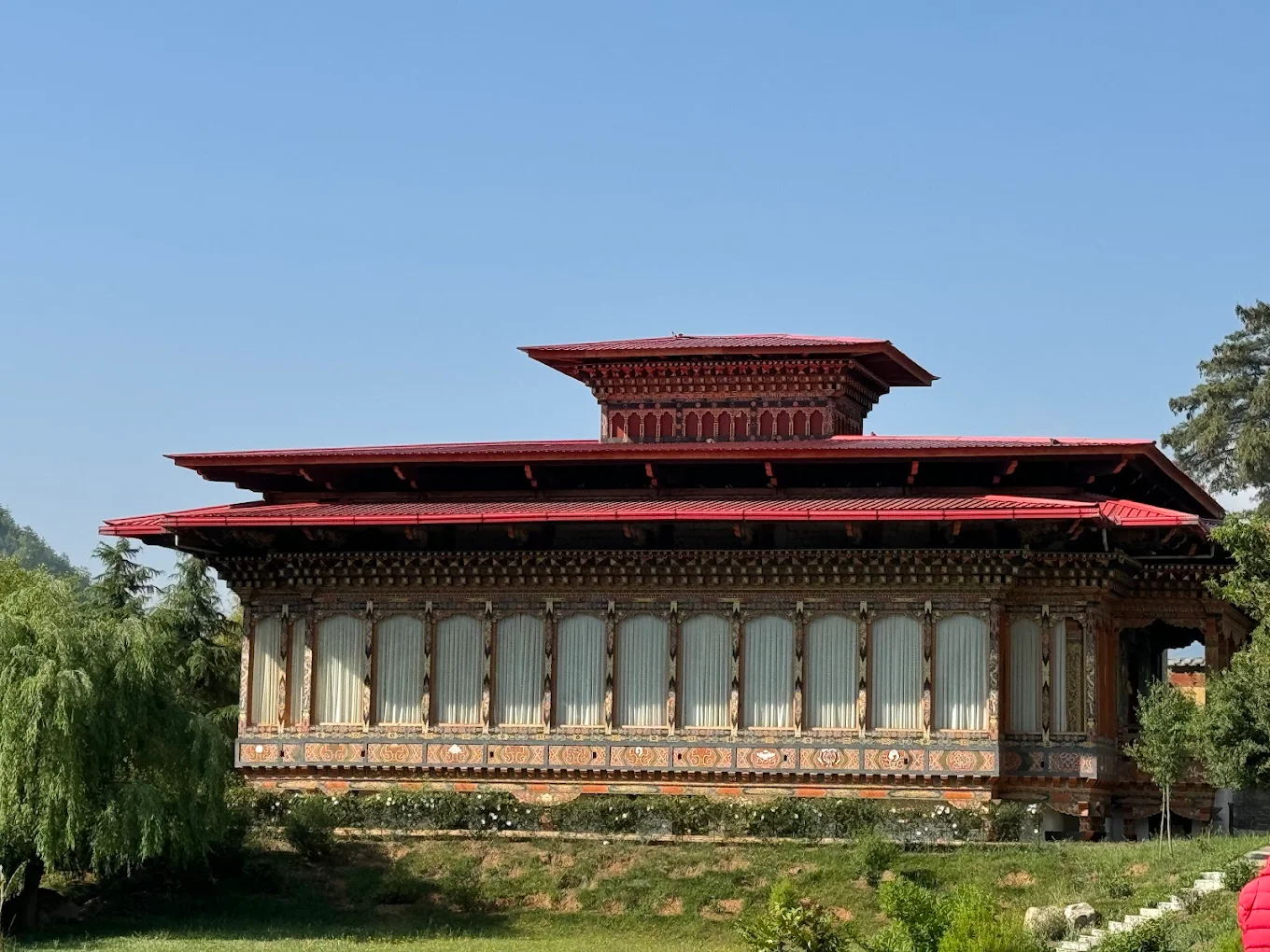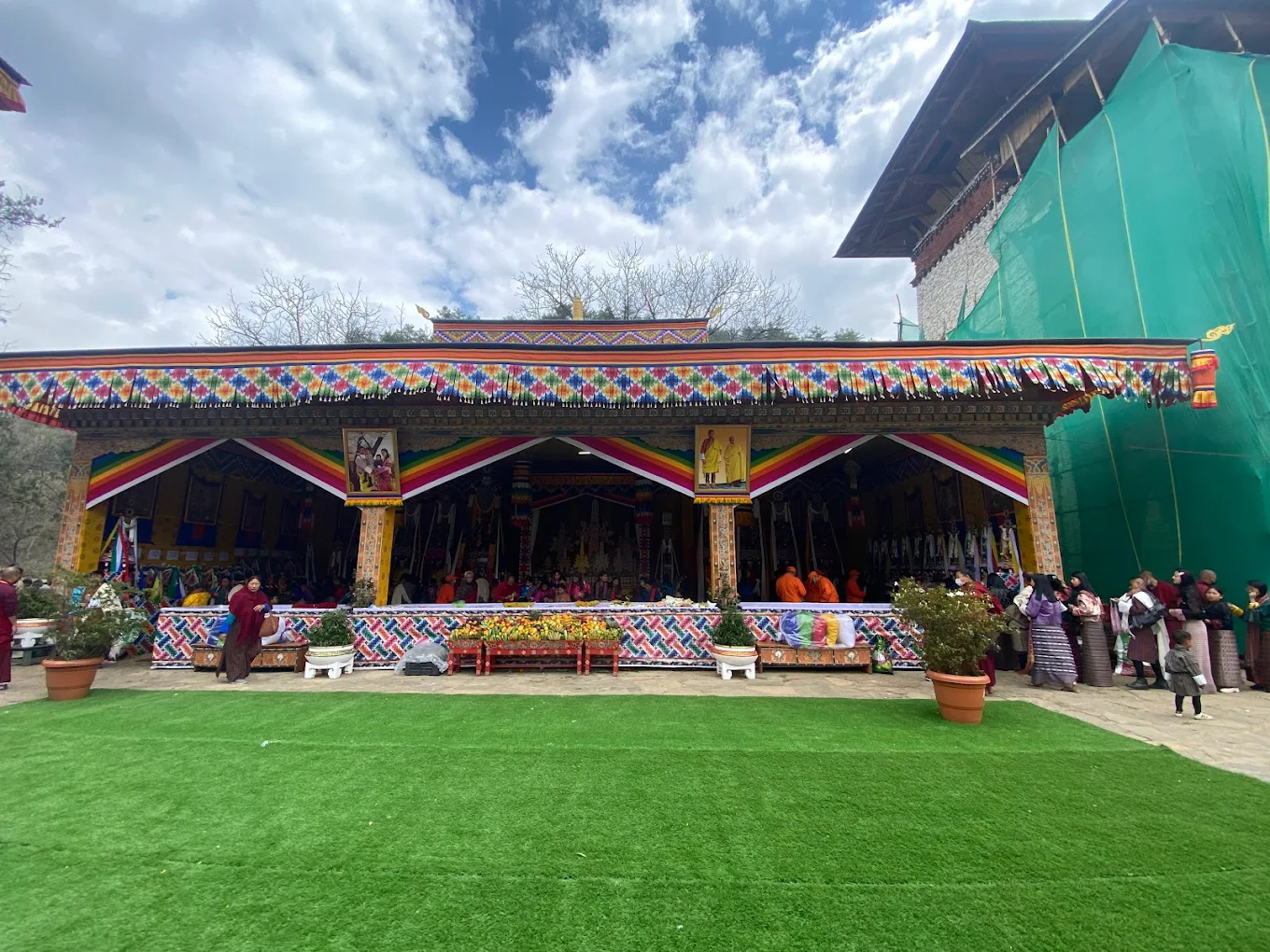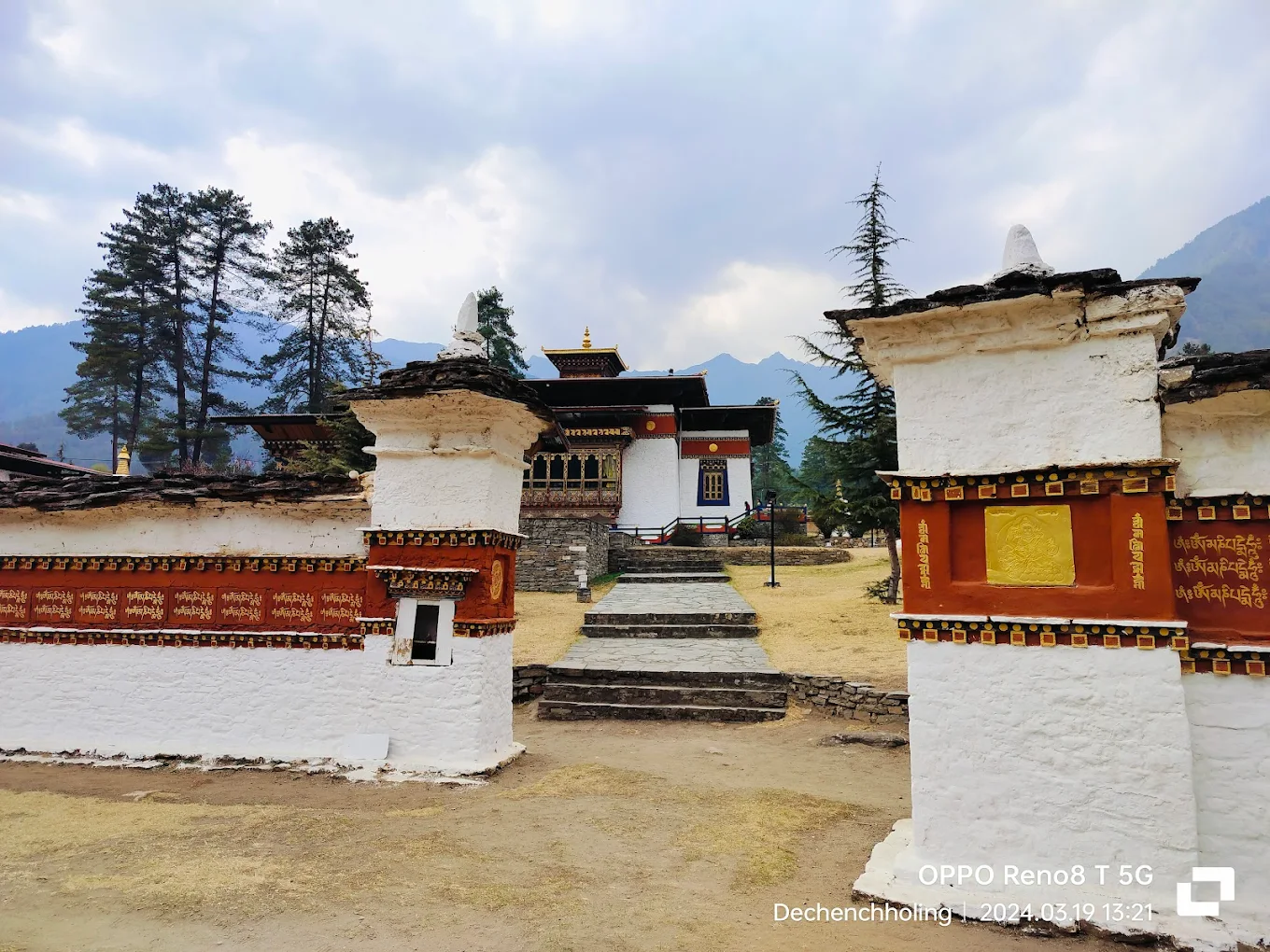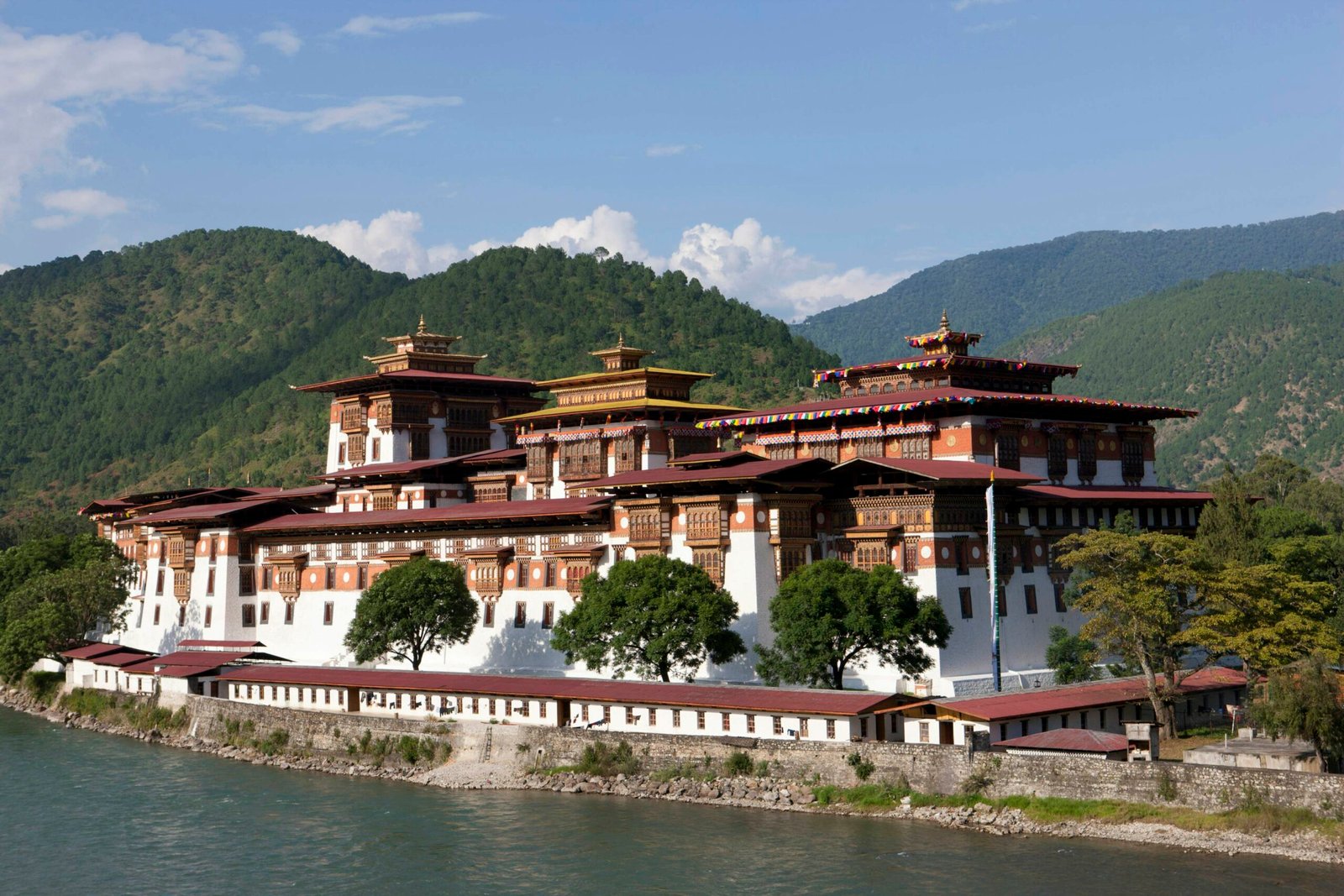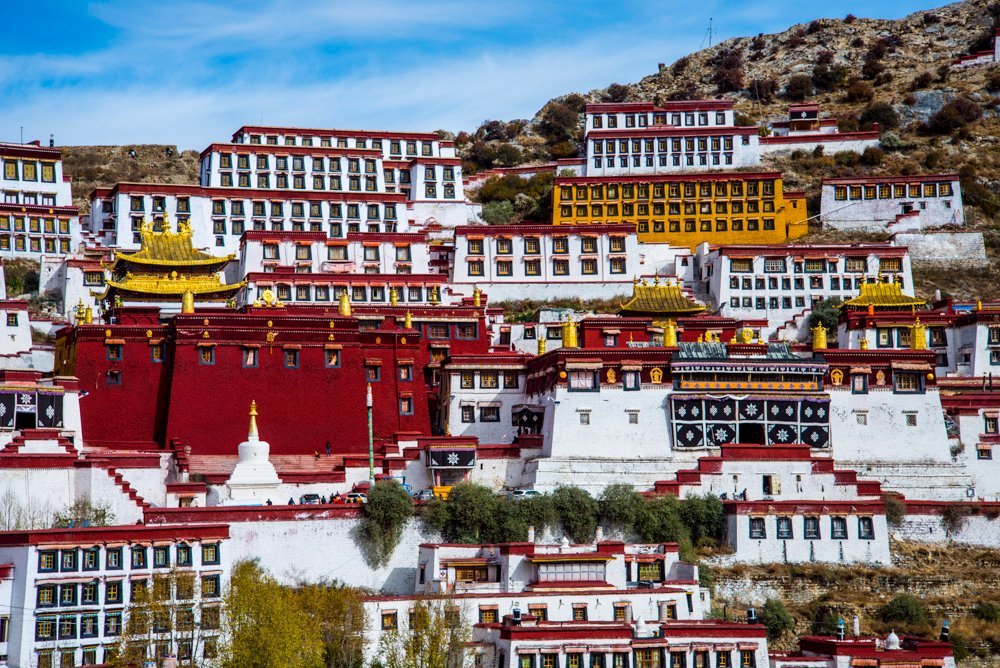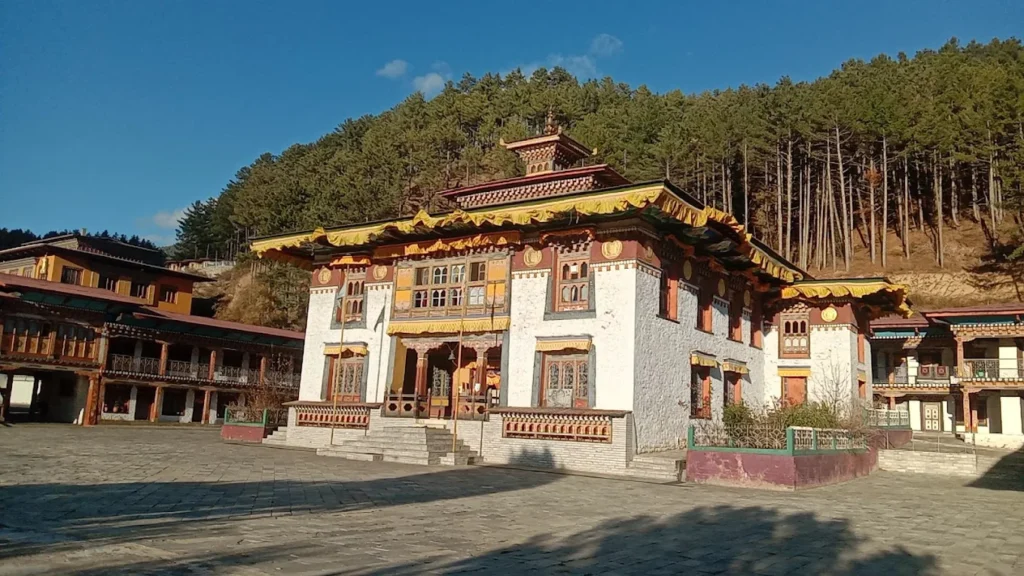Pangri Zampa Lhakhang: The Ancient Oracle of Thimphu’s Drukpa Kagyu Wisdom
At the northern edge of Thimphu’s serene valley, where the Wangchhu River flows gently through a landscape of pine and willow, Pangri Zampa Lhakhang rises with quiet dignity, its stone walls catching the first light of dawn. In the main temple (lhakhang), monks intone the Manjushri mantra, their voices resonating around a bronze statue of Guru Rinpoche, protector of Bhutan’s spiritual heritage. Founded in the 16th century by Ngawang Chogyel, this Drukpa Kagyu sanctuary serves as Bhutan’s oldest school of astrology, the revered Zodpang, its ancient halls imbued with the wisdom of celestial foresight. The air carries the scent of juniper incense, each stick lit to honor Manjushri’s insight, while prayer flags flutter above the courtyard, blessing the valley. From its riverside perch near the Wangchhu Bridge, Thimphu Dzongkhag stretches below, linking the lhakhang to Bhutan’s heart of knowledge. This sacred haven beckons travelers, seekers, and scholars to explore its hallowed grounds and embrace the enduring legacy of Drukpa Kagyu divination.
Whispers of Divination: Overview and Significance
Introduction to Pangri Zampa Lhakhang
Pangri Zampa Lhakhang, nestled on a hillside in northern Thimphu Dzongkhag, Bhutan, stands as a venerated Drukpa Kagyu sanctuary, renowned as the nation’s oldest center for astrological learning, the esteemed Zodpang, and its tranquil riverside setting. A brief journey from Thimphu’s center reveals a peaceful retreat where the murmur of the Wangchhu River and rustling willows create an atmosphere of contemplation. Named “Pangri Zampa” (meaning “sublime field” or “jeweled field”), it embodies Bhutan’s spiritual heritage, harmonizing meditation with the ancient art of celestial wisdom. A cultural and spiritual treasure, the lhakhang weaves a rich tapestry of history, astrology, and Himalayan reverence.
Historical Journey
Pangri Zampa Lhakhang traces its origins to the 16th century, when Ngawang Chogyel, a revered Drukpa Kagyu lama and ancestor of the Shabdrung lineage, established it as a meditation and astrological retreat. By the late 16th century, under the patronage of Ngawang Namgyal, it evolved into the Zodpang, Bhutan’s pioneering school of astrology, training royal seers with profound skill. Expanded in the 17th century with additional lhakhangs, its stone structure has withstood the test of time. Recent community efforts have ensured its preservation, maintaining its role as a pilgrimage and educational sanctuary.
Cultural Significance
- Drukpa Kagyu Devotion: Anchored in the Drukpa Kagyu lineage, the lhakhang venerates Guru Rinpoche and Manjushri, emphasizing meditation and intellectual pursuit.
- Bhutanese Heritage: A spiritual pillar for the Bhutanese, it preserves rituals such as mantra recitation and astrological consultations, reflecting national identity.
- Astrological Legacy: The Zodpang has shaped Bhutan’s spiritual guidance, training astrologers for the royal court.
- Regional Influence: Pilgrimages and festivals draw devotees from Thimphu and eastern Bhutan, fostering a sense of unity.
Unique Legacy
- Oldest Astrology School: The Zodpang, founded in the 16th century, stands as Bhutan’s first center for celestial wisdom.
- Ngawang Chogyel’s Vision: His establishment laid the foundation for Bhutan’s astrological tradition.
- Riverside Serenity: Its location near the Wangchhu enhances meditative focus, setting it apart among Thimphu’s lhakhangs.
- Cultural Symbol: Its enduring presence reflects Bhutan’s spiritual and intellectual heritage.
Community and Global Impact
- Local Devotion: The lhakhang hosts retreats and astrological sessions, strengthening Bhutanese Buddhist ties.
- Pilgrimage Hub: Hundreds visit annually, drawn by its celestial reputation and serene setting.
- Global Appeal: International scholars and meditators seek its astrological legacy and spiritual ambiance.
- Cultural Dialogue: Shared rituals unite Bhutanese and global visitors, fostering cross-cultural understanding.
Modern Relevance
- Spiritual Retreat: Pangri Zampa offers a sanctuary for mindfulness amidst modern challenges.
- Cultural Preservation: It safeguards Drukpa Kagyu practices and astrological traditions.
- Educational Influence: The Zodpang continues to guide Bhutan’s spiritual forecasting.
Historical Anecdotes
- Ngawang’s Founding: His 16th-century vision established the Zodpang’s sanctity.
- Royal Patronage: Ngawang Namgyal’s support elevated its role in Bhutan’s court.
- Astrological Feats: Tales of accurate predictions for the royal family enhance its prestige.
Social Role
- Community Hub: Festivals and consultations unite Thimphu’s Buddhists.
- Educational Center: Astrologers train in celestial arts, nurturing spiritual guidance.
- Charitable Spirit: Communal feasts embody Drukpa Kagyu’s compassion.
Artistic Influence
- Thangka Art: Murals of Manjushri inspire Bhutanese artists with their intellectual depth.
- Cultural Icon: The lhakhang’s riverside vista graces local artistic expressions.
- Festival Art: Cham dance costumes highlight the richness of Bhutanese craftsmanship.
Simtokha Dzong’s stone ramparts, rising above Thimphu’s southern gateway, weave a narrative of devotion and defense that defines Bhutan’s Drukpa Kagyu legacy. The journey through Pangri Zampa Lhakhang’s history, from Ngawang Chogyel’s meditative vision to its enduring role as the Zodpang, pulses with the wisdom of celestial insight, uniting monks, astrologers, and pilgrims. Its sacred halls and tranquil trails set the stage for an architectural tapestry that mirrors its Himalayan soul. As we delve into its physical and spiritual features, Pangri’s design reveals how its graceful beauty nurtures profound knowledge and contemplation.
Crafted by the River: Architectural and Spiritual Features
Iconic Design
Pangri Zampa Lhakhang’s architecture harmonizes Bhutanese Drukpa Kagyu elegance with its picturesque riverside setting, crafting a sanctuary that blends seamlessly with Thimphu’s gentle valley. Whitewashed stone walls and intricately carved wooden roofs, adorned with prayer flags, rise gracefully from the 2,300-meter elevation, embodying Buddhist serenity and intellectual pursuit. The thoughtful layout, centered on the main lhakhang, prioritizes meditative and astrological functions, with open courtyards fostering a sense of community. Positioned near the Wangchhu Bridge, its elevated vantage point over Thimphu Dzongkhag enhances its sacred resonance, linking the lhakhang to Bhutan’s Himalayan spiritual ethos.
Key Structures
- Main Lhakhang: The spiritual and astrological heart, housing Manjushri’s statue, constructed in the 16th century.
- Zodpang Halls: Dedicated classrooms for astrology training, expanded in the 17th century.
- Chorten Courtyard: A serene space with stone stupas honoring past lamas, encircled by prayer wheels.
- Meditation Chambers: Compact rooms for astrologers and monks, subtly integrated into the hillside.
- Prayer Flag Poles: Tall structures adorned with colorful flags, lining the riverside perimeter.
- Library Pavilion: A modest repository of astrological manuscripts, supporting Zodpang studies.
- Guest Quarters: A humble area for pilgrims, harmonizing with the valley setting.
Worshipped Statues
- Manjushri: A finely crafted bronze statue in the lhakhang, depicted in a meditative pose, embodies the deity of wisdom and intellectual guidance.
- Guru Rinpoche (Padmasambhava): A resplendent gilt statue, radiating serenity and spiritual protection.
- Chenrezig (Avalokitesvara): A polished white stone statue, symbolizing compassion, positioned beside the altar.
- Spiritual Role: Monks and devotees offer butter lamps to Manjushri and Guru Rinpoche, seeking divine wisdom and celestial insight.
Materials and Techniques
- Construction: Utilizes local stone and timber, expertly joined with traditional Bhutanese methods to endure valley conditions.
- Artistry: Exquisite thangka murals and wooden carvings, created by skilled Thimphu artisans, reflect Drukpa Kagyu symbolism.
- Cultural Essence: The design emphasizes astrological and meditative simplicity, distinct from the grandeur of dzong architecture.
Signature Elements
- Zodpang Halls: The astrology school remains the cornerstone of the lhakhang’s spiritual mission.
- Chorten Cluster: Stone stupas symbolize celestial wisdom, a distinctive architectural highlight.
- Prayer Flags: Gracefully fluttering flags carry prayers across the valley, enhancing its sacred ambiance.
Lesser-Known Features
- Ancient Thangkas: Faded yet vibrant murals in the lhakhang depict the manifold forms of Manjushri.
- Hidden Relic: A small astrological artifact, preserved from the Zodpang’s early days.
- Venerable Prayer Wheel: A timeworn mani wheel, in use since the 17th century, adds historical depth.
Preservation Efforts
- Restoration (17th Century): Expanded with community dedication, preserving the original aesthetic.
- Challenges: Monsoon erosion impacts stonework, necessitating ongoing maintenance.
- Modern Enhancements: Solar-powered lighting improves evening accessibility and safety.
Environmental Integration
- River Harmony: The lhakhang’s design respects the delicate Wangchhu River ecosystem.
- Eco-Practices: Monks diligently maintain the grounds and safeguard local flora.
- Wildlife Sanctuary: The presence of birds and small mammals enriches the serene atmosphere.
Artisan Narratives
- Mural Artists: Thimphu artisans meticulously restored thangka paintings, preserving sacred heritage.
- Stone Craftsmen: Local masons rebuilt walls, seamlessly blending tradition with durability.
- Flag Creators: Devoted nuns wove prayer flags, infusing each with spiritual blessings.
Symbolic Details
- Prayer Flags: The five colors represent elemental balance, disseminating dharma across the region.
- Chortens: Embody the Buddha’s enlightened mind, guiding astrological pursuits.
- Thangkas: Illustrate the path to wisdom, inspiring both study and meditation.
Landscape Integration
- Riverside Elevation: Enhances the focus on astrological and meditative practices.
- Wangchhu Perspectives: The river’s gentle flow mirrors the calm of inner reflection.
- Willow Groves: Offer solitude and a profound spiritual resonance.
The architectural elegance of Pangri Zampa Lhakhang, with its riverside lhakhangs and sacred courtyards, transcends mere stone and wood, serving as a sanctuary where the Drukpa Kagyu practices of meditation and astrology flourish. The statues of Manjushri and Guru Rinpoche, aglow with the warm light of butter lamps, stand as focal points for rituals that connect monks and devotees to Bhutan’s spiritual lineage. These hallowed spaces, vibrant with chants and celestial study, beckon visitors to partake in the lhakhang’s living traditions. As we turn to its rituals, Pangri’s role as a meditative and educational retreat emerges vividly, guiding its community toward wisdom and divine insight.
Rites of the Diviner: Rituals and Practices
Daily Sacred Rites
- Morning Chanting: Monks intone the Manjushri mantra at dawn, cultivating wisdom and clarity.
- Meditation Sessions: Periods of silent meditation, held twice daily, center on Mahamudra practices to deepen spiritual awareness.
- Butter Lamp Offerings: Devotees kindle lamps before Manjushri, offering prayers for celestial guidance.
Unique Practices
- Astrological Divinations: Monks conduct consultations using Zodpang techniques, a distinctive Drukpa Kagyu tradition, predicting fortunes and spiritual paths.
- Manjushri Puja: Ceremonies honor the wisdom deity, seeking blessings for Bhutan’s prosperity.
- Signature Ritual: The offering of juniper incense at the altar, intricately linked to the lhakhang’s astrological heritage, fosters a connection to the cosmos.
Festival Traditions
- Pangri Tshechu (15th day, 3rd lunar month): A majestic procession featuring cham dances and offerings to Manjushri draws a multitude of pilgrims.
- Lhabab Duchen: Solemn ceremonies celebrate the Buddha’s descent, with devotees circumambulating the chorten cluster.
- Losar (Bhutanese New Year): Monks perform purification rites, extending blessings to all visitors.
- Statue Veneration: The statue of Manjushri is adorned with silk vestments during festivals, symbolizing reverence and divine favor.
Visitor Engagement
- Accessible Rituals: Visitors are welcome to join morning chants or observe astrological consultations, under the gentle guidance of monks.
- Offerings: Butter lamps and prayer flags, graciously provided at the lhakhang, encourage active participation.
- Drukpa Etiquette: A respectful bow before the statues and a hushed demeanor during rituals are customary observances.
Spiritual Community Roles
- Monastics: Approximately 30 monks lead rituals and pursue astrological training with dedication.
- Astrologers: Senior lamas oversee Zodpang studies, offering counsel to the royal court and beyond.
- Lay Devotees: Thimphu villagers contribute by maintaining the grounds and providing essential supplies.
Interfaith Connections
- Syncretic Practices: Some devotees blend Buddhist rituals with Bon offerings, honoring the spirits of the land.
- Outreach Initiatives: Festival gatherings embrace diverse faiths, promoting a spirit of unity.
- Educational Outreach: Monks share insights into astrological wisdom with interested visitors.
Ritual Symbolism
- Butter Lamps: Embody the illumination of wisdom, dispelling the shadows of ignorance.
- Juniper Incense: Represents purification and a bridge to celestial realms.
- Cham Dances: Portray spiritual victories over earthly obstacles, enriching the festival experience.
Seasonal Variations
- Spring Ceremonies: Adorned with blooming willows, the season is ideal for Pangri Tshechu celebrations.
- Winter Study: The crisp air enhances the focus of Zodpang scholars.
- Monsoon Chants: The gentle rain amplifies the resonance of mantra recitations.
Monastic Life
- Daily Routine: Monks awaken at 5:00 AM for chants, meditation, and astrological study.
- Community Service: Monks guide pilgrims and ensure the upkeep of lhakhangs.
- Training Hub: Astrologers undergo 5–7 years of rigorous training, shaping Bhutan’s spiritual guidance.
The sacred rituals of Pangri Zampa Lhakhang, from the resonant Manjushri mantra to the intricate astrological consultations, infuse its riverside sanctuary with a vibrant spiritual energy, linking devotees to the Drukpa Kagyu lineage. The lhakhang’s meditative and divinatory practices, deeply rooted in Bhutan’s celestial faith, invite visitors to engage with its soul, whether through chants or quiet observation. For travelers, these rites offer a profound glimpse into Thimphu’s sacred traditions, accessible within its serene precincts. As we transition to visitor information, the lhakhang’s riverside location guides practical planning, ensuring a meaningful pilgrimage to this oracular sanctuary.
Pilgrimage to Wisdom: Visitor Information
Navigating to Pangri Zampa Lhakhang
- Location: Northern Thimphu Dzongkhag, 2,300 meters, approximately 10 km from Thimphu’s center, situated near the Wangchhu Bridge.
- Landmarks: Adjacent to Dechencholing Palace and the river, marked by clear Dzongkha and English signage.
- Routes: Accessible by a leisurely walk or drive from Thimphu’s northern road, a short distance from the bridge.
Address of Pangri Zampa Lhakhang
- Dzongkha: Pangri Zampa Lhakhang, Thimphu Dzongkhag, Bhutan.
- English: Pangri Zampa Lhakhang, Thimphu District, Bhutan.
Visiting Hours and Etiquette
- Hours: Open daily from 6:00 AM to 5:00 PM, with astrological consultations available in the morning.
- Etiquette: Visitors are encouraged to dress modestly, remove footwear before entering lhakhangs, and refrain from disrupting rituals.
- Drukpa Custom: Offer butter lamps with both hands and perform a respectful bow before the statues.
Transport Options
- By Foot: A pleasant 20-minute walk from Thimphu’s northern outskirts.
- By Taxi: A direct drive to the lhakhang’s entrance provides convenient access.
- By Bicycle: A scenic ride suits those seeking an active journey.
Accessibility and Safety
- Mobility: The flat terrain is generally accessible, though some interior stairs may pose challenges for those with mobility issues.
- Safety: Well-maintained pathways and the presence of monks ensure a secure visit.
- Tips: Comfortable footwear is recommended for indoor exploration, and visitors should proceed with care.
Amenities and Surroundings
- Facilities: Restrooms and a modest library offer access to texts and a place to rest.
- Nearby: Dechen Phodrang Monastery and Tashichho Dzong, within 6 km, provide enriching cultural experiences.
- Dining: Vegetarian meals are available at Thimphu’s nearby eateries, such as the Folk Heritage Museum.
Immersive Visitor Tips
- Best Timing: Morning visits afford the tranquility of chants and a cooler climate.
- Sensory Moments: Breathe in the fragrant willow-scented air and listen to the soothing mantra recitations.
- Statue Connection: Offer butter lamps to Manjushri and take a moment for quiet reflection.
- Festival Planning: Participate in the Pangri Tshechu to witness the vibrant cham dances.
Nearby Cultural Experiences
- Dechen Phodrang Monastery: A monastic training center, 4 km away, blends history and spirituality.
- Tashichho Dzong: Thimphu’s majestic fortress, 6 km away, offers cultural depth.
- Changangkha Lhakhang: A picturesque hilltop monastery, 5 km away, provides scenic vistas.
Photography Tips
- Best Angles: Capture the chorten cluster at sunrise to highlight the golden light.
- Respectful Shots: Refrain from photographing astrologers during consultations unless permitted.
- Scenic Views: The Wangchhu River offers breathtaking landscape opportunities.
- Equipment: A smartphone or lightweight camera is sufficient for this compact site.
The pilgrimage to Pangri Zampa Lhakhang, guided by the serene trails along the Wangchhu River, is a journey that merges spiritual discovery with intellectual enrichment, inviting visitors to engage with its Drukpa Kagyu traditions. The lhakhang’s hallowed halls and courtyards, resonant with chants and astrological study, open a window into Bhutan’s sacred heart, where wisdom feels profoundly accessible. Beyond its tranquil riverside setting, Pangri’s deeper cultural and spiritual significance enhances the experience, unveiling the essence of Himalayan Buddhism. As we delve into these insights, the lhakhang’s role as a beacon of divination and learning emerges with greater clarity, deepening our connection to its sacred legacy.
Insights of the Celestial: Cultural and Spiritual Reflections
Drukpa Kagyu Philosophy
Pangri Zampa Lhakhang embodies the essence of Drukpa Kagyu philosophy, where compassion and wisdom intertwine through meditation and astrological insight. The revered figures of Manjushri and Guru Rinpoche inspire devotees to pursue intellectual and spiritual enlightenment, mirrored in the lhakhang’s chants and divinations. The Mahamudra teachings, emphasizing the direct realization of the mind’s nature, guide monks and astrologers toward a profound understanding of the cosmos.
Environmental Spirituality
The lhakhang’s riverside location connects it to the Himalayan reverence for nature’s harmony. The gentle flow of the Wangchhu River and the surrounding willow forests cultivate a meditative calm, with offerings made to honor local deities. This natural setting invites visitors to reflect on the delicate balance between humanity and the environment.
Artistic Symbolism
The thangka murals adorning the lhakhang depict Manjushri’s wisdom, symbolizing intellectual triumph over ignorance. The chortens stand as embodiments of the Buddha’s enlightened mind, while the prayer flags’ vibrant colors represent elemental equilibrium. These artistic elements weave the Drukpa Kagyu ideals into the lhakhang’s spiritual and aesthetic fabric.
Community Resilience
Established by the devoted followers of Ngawang Chogyel, Pangri Zampa Lhakhang reflects the enduring resilience of the Bhutanese people through the passage of time. Its role as the Zodpang underscores a collective faith, sustained by the dedicated efforts of volunteers, uniting Thimphu’s Buddhist community in a shared spiritual journey.
Environmental Stewardship
The lhakhang’s pristine grounds foster the Buddhist ethic of environmental stewardship. Monks diligently protect the Wangchhu watershed and maintain the surrounding trails, ensuring ecological harmony. Visitors are encouraged to tread lightly, honoring the valley’s natural sanctity with every step.
Meditative Practices
The practice of Drukpa Kagyu meditation, including Mahamudra, nurtures a deep awareness within the lhakhang’s sacred spaces. The meditation chambers provide retreats for astrological contemplation, guided by experienced lamas, enhancing inner peace amidst the serene riverside setting of Thimphu.
Cultural Narratives
- Ngawang’s Legacy: Tales of his 16th-century founding inspire devotion among the faithful.
- Astrological Stories: Monks recount tales of accurate predictions, bridging past and present.
- Festival Lore: The Pangri Tshechu dances preserve centuries-old traditions with grace.
Historical Context
- Astrological Foundations: Ngawang Chogyel’s work established Bhutan’s Buddhist identity in celestial arts.
- Royal Patronage: The support of Ngawang Namgyal strengthened the lhakhang’s role in the royal court.
- Cultural Continuity: The Zodpang’s legacy continues to influence Bhutan’s spiritual guidance.
Reflecting on the Journey
Pangri Zampa Lhakhang, cradled in the sacred valley of Thimphu, stands as a sanctuary where wisdom and divination converge in harmonious splendor. Its lhakhangs and courtyards, alive with the enduring legacy of Manjushri, embody the Drukpa Kagyu soul of Bhutan, inviting all to seek enlightenment. The lhakhang’s trails, worn by centuries of astrologers and pilgrims, narrate a tale of resilience and devotion, deeply rooted in Himalayan faith. Whether meditating before Guru Rinpoche, observing the Zodpang’s celestial consultations, or tracing Bhutan’s rich astrological heritage, visitors find a space to reflect and connect. As you depart, the gentle murmur of the Wangchhu River and the soft flutter of prayer flags linger, a timeless reminder that insight remains ever within reach.
